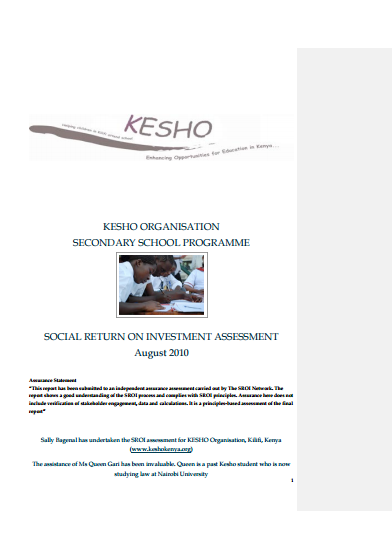Reports Database:
Kesho Organisation Secondary School Programme SROI

The Kesho Organisation’s aim is to improve the life chances through the education of disadvantaged young people in the Kilifi, Bahari and Ganze district in Coast Province, Kenya. The SROI analysis sets out to forecast the effect that the Kesho Organisation’s, Secondary School programme will have on the community. All forecast student data is based on past results.
The results:
SROI Ratio 2009/2010
90 students are sent to secondary school for a total investment of GBP 36,944. It is forecast that the social capital generated over 20 years will be GBP 697,915.93, concluding that for every one-pound invested, GBP 18.89 of social capital is created. An SROI ratio of 18.89. This exceptionally high ratio, is unsurprising in the Kenyan setting where no other opportunities to improve life chances exist.
Who are the Beneficiaries?
Eleven stakeholders were identified as potential beneficiaries, but only four stakeholders were taken forward as those that will materially benefit from the project. These are:
- The students
- The students’ families
- The project staff
- The Republic of Kenya
39% of the benefit goes to the secondary school students, who are given the long term chance of increased social mobility, and economic activity. An additional 39% of the benefit goes to the students’ families whose lives change as a reflection of their offspring’s success. As the sensitivity analysis demonstrates, the higher the number of Kesho students that progress to university, the better the life chances – increased education and health care – for the students’ families, the extended family and even the whole village in some cases.
5% of the benefit is produced by the creation of two new jobs. Against a background of a country with no safety net and where official rates of unemployment range between 40% to 83%, this project gives the two staff members the opportunity to improve the lot of their families. An average of 27% of net salaries is spent on their siblings education and family welfare.
17% of the benefit is felt by the Republic of Kenya which benefits because an average secondary school graduate will produce five times the average GDP. Capacity will be built so that Kenya can fulfil its own goals of being a middle income economy by 2030.
The Millennium Development Goals challenges the world to eradicate extreme poverty and hunger and promote gender equality and empower women by 2015. This project, in its small way, contributes to these goals.
The benefit of this type of SROI forecasting is that it enables donors to see beyond the simple unit cost of how many students are served per administrator, and focus on the long-term effect of the activity that they are funding. This SROI demonstrates value for money. Donors can be assured that their Grants will permanently improve the life chances of the 90 students, the 2 project staff and their families, totalling well over 500 people. The assessment will also inform the Kesho Organisation of the areas and activities where maximum benefit can be derived.
It is intended that an SROI evaluative analysis for the Kesho organisation will become a regular report, and it is recommended that setting up a system to keep contact with Kesho students, once they graduate from secondary school, will greatly help data collection.
